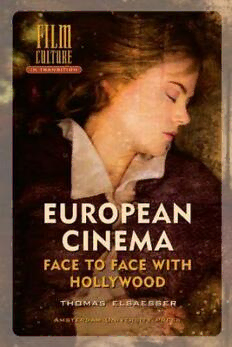Table Of Content* pb ‘European Cinema’ 10-06-2005 19:00 Pagina 1
FFIILLMM FFIILLMM
In the face of renewed competition from Holly-
wood since the early 1980s and the challenges
posed to Europe’s national cinemas by the fall
E
of the Wall in 1989, independent filmmaking in U
CCUULLTTUURREE R CCUULLTTUURREE
Europe has begun to re-invent itself. European
O
Cinema: Face to Face with Hollywood re-asses- P
E
ses the different debates and presents a broader IN TRANSITION A IN TRANSITION
framework for understanding the forces at work N
since the 1960s. These include the interface of C
I
“world cinema” and the rise of Asian cinemas, N
E
the importance of the international film festival M
circuit, the role of television, as well as the A
changing aesthetics of auteur cinema. New
audiences have different allegiances, and T
H
new technologies enable networks to re-
O
shape identities, but European cinema still M
A
has an important function in setting criti-
S
cal and creative agendas, even as its eco-
E
nomic and institutional bases are in flux. L
S
A
Thomas Elsaesser is professor of Media E
S
and Culture and Director of Research, Film S
E
and Television Studies at the University of
R
Amsterdam. Among his most recent publi-
cations are Harun Farocki – Working on
the Sight Lines (2004), and Terrorisme,
Mythes et Representations(2005).
EEUURROOPPEEAANN
CCIINNEEMMAA
FFAACCEE TTOO FFAACCEE WWIITTHH
ISBN90-5356-594-9
HHOOLLLLYYWWOOOODD
9 789053 565940 TTHHOOMMAASS EELLSSAAEESSSSEERR
AAmmsstteerrddaamm UUnniivveerrssiittyy PPrreessss
AAmmsstteerrddaamm UUnniivveerrssiittyy PPrreessss
WWW.AUP.NL
EuropeanCinema
European Cinema
Faceto Facewith Hollywood
Thomas Elsaesser
AmsterdamUniversityPress
Coverillustration:NicoleKidmaninDogville
Coverdesign:KokKorpershoek,Amsterdam
Lay-out:japes,Amsterdam
isbn(paperback)
isbn(hardcover)
nur
©AmsterdamUniversityPress,Amsterdam
Allrightsreserved.Withoutlimitingtherightsundercopyrightreservedabove,nopart
ofthisbookmaybereproduced,storedinorintroducedintoaretrievalsystem,ortrans-
mitted,inanyformorbyanymeans(electronic,mechanical,photocopying,recordingor
otherwise)withoutthewrittenpermissionofboththecopyrightownerandtheauthorof
thebook.
Table of Contents
Preface 9
Introduction
EuropeanCinema:ConditionsofImpossibility?[]
National Cinema: Re-Definitions and New Directions
EuropeanCulture,NationalCinema,theAuteurandHollywood[]
ImpersoNations:NationalCinema,HistoricalImaginaries[]
FilmFestivalNetworks:theNewTopographiesofCinemain
Europe[]
DoubleOccupancyandSmallAdjustments:Space,PlaceandPolicyinthe
NewEuropeanCinemasincethes[]
Auteurs and Art Cinemas: Modernism and Self-
Reference, Installation Art and Autobiography
IngmarBergman–PersonandPersona:TheMountainofModern
CinemaontheRoadtoMorocco[]
LateLosey:TimeLostandTimeFound[]
AroundPaintingandthe“EndofCinema”:AProposJacquesRivette’s
LaBelleNoiseuse[]
SpellboundbyPeterGreenaway:IntheDark...andIntotheLight[]
TheBodyasPerceptualSurface:TheFilmsofJohanvanderKeuken[]
TelevisionandtheAuthor’sCinema:ZDF’sDasKleineFernsehspiel[]
TouchingBase:SomeGermanWomenDirectorsinthes[]
6 EuropeanCinema:FacetoFacewithHollywood
Europe-Hollywood-Europe
TwoDecadesinAnotherCountry:HollywoodandtheCinephiles[]
RaoulRuiz’sHypothèseduTableauVolé[]
ImagesforSale:The“New”BritishCinema[]
“IfYouWantaLife”:TheMarathonMan[]
BritishTelevisioninthesThroughTheLookingGlass[]
GermanCinemaFacetoFacewithHollywood:LookingintoaTwo-Way
Mirror[]
Central Europe Looking West
OfRatsandRevolution:DusanMakavejev’sTheSwitchboard
Operator[]
DefiningDEFA’sHistoricalImaginary:TheFilmsofKonradWolf[]
UnderWesternEyes:WhatDoesŽižekWant?[]
OurBalkanistGaze:AboutMemory’sNoMan’sLand[]
Europe Haunted by History and Empire
IsHistoryanOldMovie?[]
EdgarReitz’Heimat:Memory,HomeandHollywood[]
DiscourseandHistory:OneMan’sWar–AnInterviewwith
EdgardoCozarinsky[]
RendezvouswiththeFrenchRevolution:EttoreScola’s
ThatNightinVarennes[]
JosephLosey’sTheGo-Between[]
GamesofLoveandDeath:PeterGreenawayandOtherEnglishmen[]
Border-Crossings: Filmmaking without a Passport
PeterWollen’sFriendship’sDeath[]
AndyEngel’sMelancholia[]
TableofContents
OntheHighSeas:EdgardoCozarinsky’sDutchAdventure[]
ThirdCinema/WorldCinema:AnInterviewwith
RuyGuerra[]
RuyGuerra’sErendira[]
Hyper-,Retro-orCounter-:EuropeanCinemaasThirdCinemaBetween
HollywoodandArtCinema[]
Conclusion
EuropeanCinemaasWorldCinema:ANewBeginning?[]
EuropeanCinema:ABriefBibliography
ListofSourcesandPlacesofFirstPublication
Index
Preface
The(West)Europeancinemahas,sincetheendofWorldWarII,haditsidentity
firmly stamped by three features: its leading directors were recognized as au-
teurs,itsstylesandthemesshapedanation’sself-image,anditsnewwavessig-
nified political as well as aesthetic renewal. Ingmar Bergman, Jacques Rivette,
JosephLosey,Peter Greenaway,neo-realism,thenouvellevague,NewGerman
Cinema, the British renaissance – these have been some of the signposts of a
cinemathatderivedlegitimacyfromadualculturallegacy:thatofthethcen-
turynovelandofthethcenturymodernistavant-gardes.Bothpedigreeshave
given Europe’s national cinemas a unique claim to autonomy, but they also
drew boundaries between the work of the auteur-artists, representing the na-
tion,highcultureandrealism,andthemakersofpopularcinema,representing
commerce,mass-entertainmentandconsumption.
These distinguishing features were also identity constructions. They helped
to mask a continuing process of self-definition and self-differentiation across a
half-acknowledged presence, namely of Hollywood, and an unacknowledged
absence, namely of the cinemas of Socialist Europe. Since , such identity
formations through difference, exclusion and otherness, are no longer securely
inplace.Cinematodaycontributestoculturalidentitiesthataremoreinclusive
andprocessual,moremulti-culturalandmulti-ethnic,moredialogicalandinter-
active,abletoembracethe‘newEurope’,thepopularstar-andgenrecinema,as
well as the diaspora cinemas within Europe itself. It has meant re-thinking as
well as un-thinking European cinema. Has it made cinema in Europe an anx-
iousart,seekingsalvationinthepreservationofthe“nationalheritage”?Many
times before, European cinema has shown itself capable of re-invention. This
time, the challenge for films, filmmakers and critics is to be European enough
topreserveEurope’sculturaldiversityandhistoricaldepth,aswellasoutward-
lookingenoughtobetrans-nationalandpartofworldcinema.
The essays brought together in European Cinema: Face to Face with Hollywood
present a cross-section of my writings on these topics over a period of some
thirty-fiveyears.Theyre-examinetheconflictingterminologiesthathavedomi-
natedthediscussion,includingthenotionof“thenation”in“nationalcinema”,
and the idea of the artist as creator of a unique vision, at the heart of the “au-
teur-cinema”. They take a fresh look at the ideological agendas, touching on
politically and formally oppositional practices and they thoroughly examine
Europeancinema’srelationtoHollywood.

